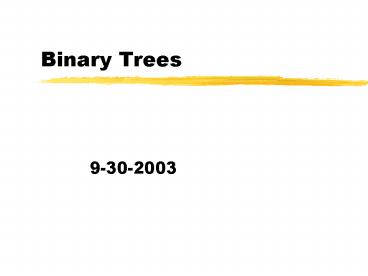Binary Trees - PowerPoint PPT Presentation
Title:
Binary Trees
Description:
We mix metaphors for biological trees and family trees when discussing them. ... Deletion is easily the hardest operation on a binary search tree. ... – PowerPoint PPT presentation
Number of Views:51
Avg rating:3.0/5.0
Title: Binary Trees
1
Binary Trees
- 9-30-2003
2
Opening Discussion
- Do you have any questions about the quiz?
- What did we talk about last class?
- Do you have any questions about the assignment?
Compare this semesters project to that from last
semester. You have less freedom in what you do
(though you still have a fair bit of freedom in
that), but you have a lot more freedom in how you
do it.
3
Trees
- A data structure that has a single root and a
single path from any node to the root is a tree. - We mix metaphors for biological trees and family
trees when discussing them. We also draw them
upside down. - Terms root, leaf, child, parent, sibling,
ancestor, descendent, height, depth, size.
4
Binary Trees
- The most common type of tree that we use is a
binary tree where a node can have two children
called left and right. - We can traverse these trees by recursively going
to the left, then the right. Depending on when
we visit the current node we get a pre-order,
in-order, or post-order traversal. - A breadth first traversal uses a queue instead of
a stack.
5
Sorted Binary Trees
- Also called a binary search tree, these trees
have a complete ordering of their elements and
things that are less go to the left while things
that are greater go to the right. - A search on this structure starts at the root and
walks down, picking the proper side to step to
until the desired node is found. This has
average case O(log n) performance.
6
Successor and Predecessor
- Unlike a hash table, we can efficiently find the
successor of any given element of a binary tree.
A similar algorithm can be used for predecessor. - If the node has a right child the successor is
the smallest element on the right. If not then
we walk up until we find a node that this one
wasnt to the left of. - These both to O(log n) time.
7
Insertion
- To insert we act like we are searching until we
get to the place the node should be. Once we get
there we place the node. - Obviously we have to be a bit more careful
because we cant go off the edge of the structure
before adding, but the idea is basically the same.
8
Deletion
- Deletion is easily the hardest operation on a
binary search tree. We have to replace the
current node with either the largest element on
the left or the smallest on the right. - If nodes keep track of their parents this can
also be greatly simplified with functions that
find the smallest or largest element of a subtree.
9
Minute Essay
- What do you see as the biggest problems with
binary search problems? - Try to get assignment 2 to a place where it
compiles and does a fair bit of the functionality
so you can submit it. Dont worry too much if it
isnt all complete, but there will be comparative
grading so if you have much less than some others
it wont reflect well.































